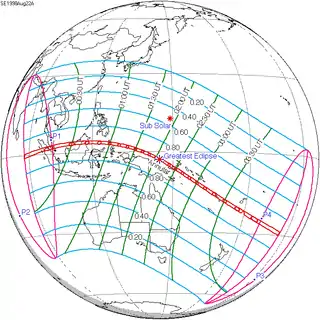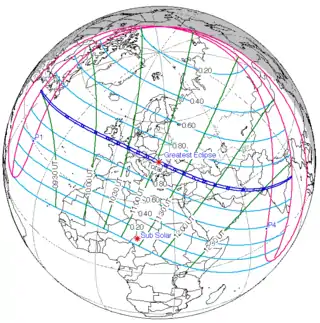Solar eclipse of February 5, 2000
A partial solar eclipse occurred on February 5, 2000. A solar eclipse occurs when the Moon passes between Earth and the Sun, thereby totally or partly obscuring the image of the Sun for a viewer on Earth. A partial solar eclipse occurs in the polar regions of the Earth when the center of the Moon's shadow misses the Earth. It was only visible over Antarctica.
| Solar eclipse of February 5, 2000 | |
|---|---|
 Map | |
| Type of eclipse | |
| Nature | Partial |
| Gamma | -1.2233 |
| Magnitude | 0.5795 |
| Maximum eclipse | |
| Coordinates | 70.2°S 134.1°E |
| Times (UTC) | |
| Greatest eclipse | 12:50:27 |
| References | |
| Saros | 150 (16 of 71) |
| Catalog # (SE5000) | 9507 |
Images

Related eclipses
Eclipses of 2000
Solar eclipses 1997–2000
This eclipse is a member of a semester series. An eclipse in a semester series of solar eclipses repeats approximately every 177 days and 4 hours (a semester) at alternating nodes of the Moon's orbit.[1]
| Solar eclipse series sets from 1997–2000 | ||||||
|---|---|---|---|---|---|---|
| Descending node | Ascending node | |||||
| Saros | Map | Gamma | Saros | Map | Gamma | |
120 Chita, Russia | 1997 March 9 Total | 0.91830 | 125 | 1997 September 2 Partial | -1.03521 | |
130.jpg.webp) Total eclipse near Guadelope | 1998 February 26 Total | 0.23909 | 135 | 1998 August 22 Annular | -0.26441 | |
| 140 | 1999 February 16 Annular | -0.47260 | 145 Totality from France | 1999 August 11 Total | 0.50623 | |
| 150 | 2000 February 5 Partial | -1.22325 | 155 | 2000 July 31 Partial | 1.21664 | |
| Partial solar eclipses on July 1, 2000 and December 25, 2000 occur in the next lunar year eclipse set. | ||||||
Metonic series
The metonic series repeats eclipses every 19 years (6939.69 days), lasting about 5 cycles. Eclipses occur in nearly the same calendar date. In addition, the octon subseries repeats 1/5 of that or every 3.8 years (1387.94 days). All eclipses in this table occur at the Moon's descending node.
| 22 eclipse events between September 12, 1931 and July 1, 2011. | ||||
|---|---|---|---|---|
| September 11-12 | June 30-July 1 | April 17-19 | February 4-5 | November 22-23 |
| 114 | 116 | 118 | 120 | 122 |
 September 12, 1931 |
 June 30, 1935 |
 April 19, 1939 |
 February 4, 1943 |
 November 23, 1946 |
| 124 | 126 | 128 | 130 | 132 |
 September 12, 1950 |
 June 30, 1954 |
 April 19, 1958 |
 February 5, 1962 |
 November 23, 1965 |
| 134 | 136 | 138 | 140 | 142 |
 September 11, 1969 |
 June 30, 1973 |
 April 18, 1977 |
 February 4, 1981 |
 November 22, 1984 |
| 144 | 146 | 148 | 150 | 152 |
 September 11, 1988 |
 June 30, 1992 |
 April 17, 1996 |
 February 5, 2000 |
 November 23, 2003 |
| 154 | 156 | 158 | 160 | 162 |
 September 11, 2007 |
 July 1, 2011 |
April 18, 2015 | February 4, 2019 | November 23, 2022 |
References
- van Gent, R.H. "Solar- and Lunar-Eclipse Predictions from Antiquity to the Present". A Catalogue of Eclipse Cycles. Utrecht University. Retrieved 6 October 2018.
.jpg.webp)

